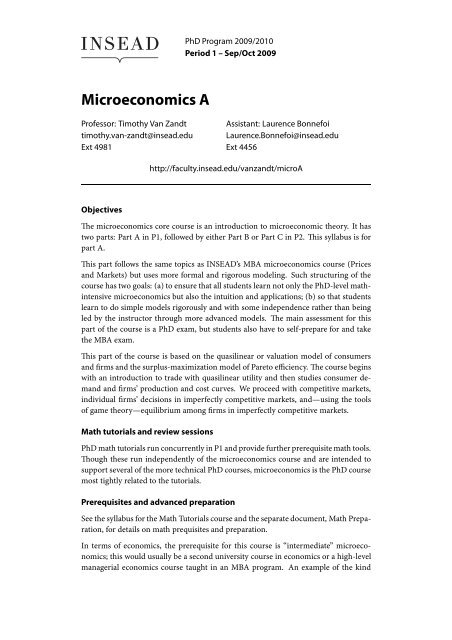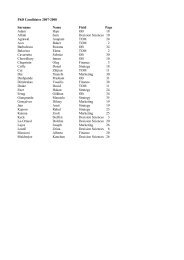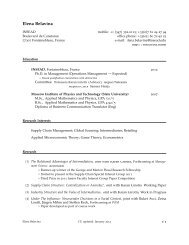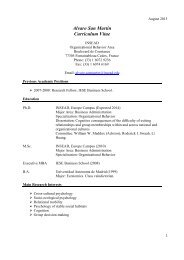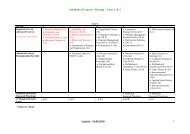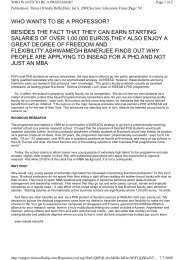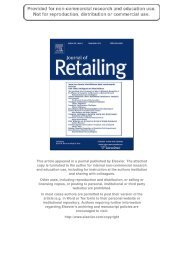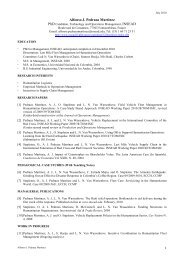Microeconomics A - INSEAD - PhD Programme
Microeconomics A - INSEAD - PhD Programme
Microeconomics A - INSEAD - PhD Programme
You also want an ePaper? Increase the reach of your titles
YUMPU automatically turns print PDFs into web optimized ePapers that Google loves.
<strong>PhD</strong> Program 2009/2010Period 1 – Sep/Oct 2009<strong>Microeconomics</strong> AProfessor: Timothy Van Zandttimothy.van-zandt@insead.eduExt 4981Assistant: Laurence BonnefoiLaurence.Bonnefoi@insead.eduExt 4456http://faculty.insead.edu/vanzandt/microAObjectivesThe microeconomics core course is an introduction to microeconomic theory. It hastwo parts: Part A in P1, followed by either Part B or Part C in P2. This syllabus is forpart A.This part follows the same topics as <strong>INSEAD</strong>’s MBA microeconomics course (Pricesand Markets) but uses more formal and rigorous modeling. Such structuring of thecourse has two goals: (a) to ensure that all students learn not only the <strong>PhD</strong>-level mathintensivemicroeconomics but also the intuition and applications; (b) so that studentslearn to do simple models rigorously and with some independence rather than beingled by the instructor through more advanced models. The main assessment for thispart of the course is a <strong>PhD</strong> exam, but students also have to self-prepare for and takethe MBA exam.This part of the course is based on the quasilinear or valuation model of consumersand firms and the surplus-maximization model of Pareto efficiency. The course beginswith an introduction to trade with quasilinear utility and then studies consumer demandand firms’ production and cost curves. We proceed with competitive markets,individual firms’ decisions in imperfectly competitive markets, and—using the toolsof game theory—equilibrium among firms in imperfectly competitive markets.Math tutorials and review sessions<strong>PhD</strong> math tutorials run concurrently in P1 and provide further prerequisite math tools.Though these run independently of the microeconomics course and are intended tosupport several of the more technical <strong>PhD</strong> courses, microeconomics is the <strong>PhD</strong> coursemost tightly related to the tutorials.Prerequisites and advanced preparationSee the syllabus for the Math Tutorials course and the separate document, Math Preparation,for details on math prequisites and preparation.In terms of economics, the prerequisite for this course is “intermediate” microeconomics;this would usually be a second university course in economics or a high-levelmanagerial economics course taught in an MBA program. An example of the kind
<strong>Microeconomics</strong> A • Syllabus 2of textbook used for such a course is Pindyck and Rubinfeld’s <strong>Microeconomics</strong>. Somesuch courses are calculus based and some are not. From our point of view, it is importantthat you know the math but not necessarily that you have taken a calculus-basedmicroeconomics course.Don’t be fooled by the fact that this course covers topics of intermediate microeconomics.It merely uses them to teach you the advanced methods of microeconomicmodelling. If you are learning the intermediate-level microeconomics at the same timeas the <strong>PhD</strong> microeconomics, and also getting up to speed in the math, then your onemicroeconomics course has become three—impossible!Therefore, come prepared. If you have not taken at least intermediate microeconomicsor if that course was more than a couple years ago, then you should study the materialbefore coming to <strong>INSEAD</strong>. You can use any intermediate microeconomics textbook,including the Pindyck and Rubinfeld book mentioned above. Alternatively—and thiswould be the most efficient if you are pressed for time—you can use the MBA lecturenotes that are required reading for P1 of this course. You can download them fromhttp://faculty.insead.edu/vanzandt/microA/Syllabus/FPM-Aug2006.pdfHomeworkI will give out a problem set for each topic, due one week later. These will be gradedmainly for effort and completeness.GradingThis course has an MBA exam, which counts for 25%, and a <strong>PhD</strong> exam, which countsfor 65%. The homework counts toward 10% of the grade.Continuation in P2There are two versions of the second half of the microeconomics core course in P2(Nov–Dec):<strong>Microeconomics</strong> B. This version continues the development of mathematicalmicroeconomic modeling.<strong>Microeconomics</strong> C. This version covers the essentials of microeconomics forempirical (econometric and qualitative) work.This is the second year that we have two versions and the exact content and restrictionsare yet evolving. Students in some fields will be required to take <strong>Microeconomics</strong> B,which is also a prerequisite for the Game Theory and Industrial Organization courses.Otherstudentswillbeabletochoosewhichcoursetotake.Inprinciplethetwocourseswill be more complementary than substitutes for one another, but we do not anticipatethat students would take both courses. You will receive further details in P1.
<strong>Microeconomics</strong> A • Syllabus 3Honor codeStudents are expected, individually and collectively, to uphold the rules of the <strong>PhD</strong>program and the professional norms regarding cheating and plagiarism. If you haveany doubts about what entails cheating, consult with one of the professors or withthe <strong>PhD</strong> program office. Violations, even in the form of facilitating cheating by otherstudents, may result in a failure grade or expulsion from the program.The homework exercises are provided for your pedagogical benefit. There are no rulesgoverning the execution of the exercises, other than that each student must hand inhis or her solutions separately. Collaboration, such as working in groups or consultingwith students from previous years, is encouraged to the extent that it helps you learnthe material.Simply copying from group members or consulting past solutions would invalidatethe pedagogical value of the exercises and it is up to you to avoid this. Such actions aretypically viewed very dimly by classmates, who take satisfaction from the challenge ofthe exercises.Exams are entirely individual. Collaboration of any form during an exam constitutescheating.
<strong>Microeconomics</strong> A • Syllabus 4Course contentOverviewThis part of the course is unusual. It is like two courses in one—a self-study course atthe MBA level and an in-class <strong>PhD</strong> course.• Self-studyMBA course. YouwillreceivetheMBAcoursepack,includingthelecturenotes called Firms, Prices, and Markets (FPM). In advance of each class, you mustread the assigned FPM readings and hand in selected assigned exercises, listed as“Preclass assignment” in the outline. At the end of the period, your have to takethe same exam as the MBA students. You exam will not be curved together withthe MBA students and you will not be informed how your grade compares withtheirs.• <strong>PhD</strong> course. We cover the same MBA topics in class but with full rigorous modelingand proving the assertions that appear in the MBA course. A typical class begins:“Ok, how can we formally model what is in the FPM chapter? We want to be veryprecise—even pedantic—and prove the assertions in the chapter. We should try togeneralize the results.” You will have to rely on in-class notes, occasional printedlecture notes, and some supplementary readings. The problem sets and additionalexercises are also an integral part of the course material. You will have a final exam.Main textbooks1. Bolton, Patrick and Mathias Dewatripont. Contract Theory. MIT Press, 2005.[“BD”]2. Mas-Colell, Andreu, Michael Whinston, and Jerry Green. Microeconomic Theory.Oxford: Oxford University Press. 1995. [“MWG”]3. Osborne, Martin. An Introduction to Game Theory. Oxford University Press, 2004.[“Osborne”]4. Van Zandt, Timothy. Firms, Prices & Markets. 2006. [“FPM”]5. Varian, Hal. Microeconomic Analysis. 3rd edition. Norton & Co., 1992. [“Varian”]You will receive a copy of the MBA Prices and Markets course pack, which contains allthe FPM readings and additional MBA readings that you will need. You will receivean additional coursepack with <strong>PhD</strong> documents and textbook readings.Due to copyright restrictions, the later readings from the Varian and Osborne textbooks—markedby*onthissyllabus—arenotinthecoursepack.Youhavetoeitherpurchasethe books, consult them in the library, or borrow from upper-year students. I recommendthat you purchase Varian’s book because it is a useful standard reference.Preparation guidesFor each topic, there is a preparation guide in the <strong>PhD</strong> course pack. This outlines theadvanced preparation, readings, and other assignments required for each topic.
<strong>Microeconomics</strong> A • Syllabus 5List of topicsThe topics are numbered 1 to 14 to match our fourteen 1.5-hour sessions.Demand, Supply, and Equilibrium1. Pareto efficiency with quasilinear utility2. Choice and equilibrium with quasilinear utility3a. Empirical estimation of demandProduction and Costs3b. Production and technology4. Cost functionsPerfect Competition5. Competitive supply and market price6. Short-run costs and pricesSingle-Firm Pricing Decisions with Market Power7. Pricing with market power8. How pricing depends on the demand curve9. Explicit price discrimination10. Monopolistic screening without adverse selectionGame Theory and Imperfect Competition11. Static games and Nash equilibrium12. Imperfect competition13. Explicit and Implicit Cooperation14. Strategic commitment
<strong>Microeconomics</strong> A • Syllabus 6OutlineI only list readings that are directly related to the topics as I will cover them. You canfind extensions in MWG and the other references.MBA 3 ⇒ (e.g.) the material is in the MBA course pack under Session 3.FPM ⇒ MBA lectures, in the MBA course pack.* ⇒ the reading is not in the course pack due to copyright restrictions.Unit I.Demand, Supply, and EquilibriumTopic 1.Pareto efficiency with quasilinear utilityThe quasi-linear model of partial equilibrium with money and one good. Total valuationand marginal valuation. Total cost and marginal cost. Pareto optimality andsurplus maximization. First-order conditions for Pareto optimality.Readings:FPM Math Review, PreliminariesFPM Ch. 1Preclass assignment:FPM Exercise P.1. Do part (c) twice: Once with Excel and once with Mathematicaor equivalent.Topic 2.Choice and equilibrium with quasilinear utilityDemand, supply, and competitive equilibrium. Elasticity of supply and of demand.Effect of taxes.Readings:FPM Chs. 2 and 3Varian Ch. 13 (except §13.5)Preclass assignment:FPM Exercises 2.5 and 3.3Topic 3a.Empirical estimation of demandEstimating constant-elasticity demand using OLS.Preclass assignment:MBA 3 “Estimating the Elasticity of Demand for Gasoline”
<strong>Microeconomics</strong> A • Syllabus 7Unit II.Production and CostsTopic 3b.Production and technologyTechnology, production functions, and profit maximization of firms. Returns to scale.Law of diminishing marginal product.Readings:Varian Ch. 1, 2, *3Topic 4.Cost functionsSunk costs and opportunity costs. Analysis of cost curves—fixed versus variable cost,marginal versus total cost. Economies of scale. Deriving cost curves from productionfunctions.Readings:FPM Ch. 4MBA 4 “Long-RunFixedCostsintheCellularIndustry”∗ Varian Chs. 4 and 5Preclass assignment:FPM Exercises 4.4 and 4.5Unit III.Perfect CompetitionTopic 5.Competitive supply and market priceCompetititive supply and market price.Readings:FPM Ch. 5MWG Ch. 10Preclass assignment:FPM Exercises 5.3 and 5.4MBA 5 “Simulation of a Perfectly Competitive Market”
<strong>Microeconomics</strong> A • Syllabus 8Topic 6.Short-run costs and pricesShort-run cost curves. Trade-off between fixed cost and marginal cost. Law of diminishingreturn. Short-run versus long-run pricing and supply. Industry volatility andovershooting. Capacity constraints.Readings:FPM Ch. 6Preclass assignment:FPM Exercises 6.1 and 6.2Continuation of simulation exerciseUnit IV.Single-Firm Pricing Decisions with Market PowerTopic 7.Pricing with market powerPricing with market power. Socially efficient quantity, profit-maximizing quantity,deadweight loss. Pricing with linear demand and constant-elasticity demand. Entryand exit decisions with a long-run fixed cost.Readings:FPM Ch. 8MBA 8 “Apple Slips”∗ Varian §14.1–14.4MWG §12.A–BPreclass assignment:FPM Exercises 8.4–8.8Topic 8.How pricing depends on the demand curveEffects of a shift in the demand curve on pricing. Marginal revenue and elasticity. Effectofashiftinelasticityonpricing,withconstantmarginalcost.Effectofanincreaseinthe volume of demand on pricing, with increasing marginal cost.Readings:FPM Ch. 9Preclass assignment:FPM Exercise 9.3
<strong>Microeconomics</strong> A • Syllabus 9Topic 9.Explicit price discriminationCharging different prices in different market segments.Readings:FPM Ch. 10MBA 10 “Will the Roxy Theater Maximize Profits by Eliminating …”Preclass assignment:On-line survey about “Roxy Theater”Topic 10.Monopolistic screening without adverse selectionPrivate information about valuations and the extraction of surplus. Perfect price discrimination.Informational requirements of perfect price discrimination. Methodsfor screening when consumer characteristics cannot be observed. Menus and selfselection.Versioning. Bundling. Nonlinear pricing.Readings:FPM Chs. 11 and 11BBD §2.1Preclass assignment:FPM Exercises 11.1–11.4 and 12.4Unit V.Game Theory and Imperfect CompetitionTopic 11.Static games and Nash equilibriumPlayers, actions, timing, and payoffs. Dominant strategies. Best responses and bestreplycurves. Strategic complements and substitutes. Dominant-strategy equilibrium.Nash equilibrium.Readings:FPM Ch. 12Osborne Chs. 1 and 2Preclass assignment:FPM Exercise 12.5
<strong>Microeconomics</strong> A • Syllabus 10Topic 12.Imperfect competitionPrice competition with differentiated products. Quantity competition with perfectsubstitutes (Cournot). Imperfect competition with free entry.Readings:FPM Ch. 13∗ Osborne Ch. 3 (available at http://www.economics.utoronto.ca/osborne/igt)MBA 13 “Gamebox: Another Kind of Network Externality”Preclass assignment:“Imperfect Competition with Free Entry”Topic 13.Explicit and Implicit CooperationExternalities and the inefficiency of Nash equilibrium. Role of positive and negativeexternalities. Repeated games and tacit collusion. Trigger strategies.Readings:FPM Ch. 14∗ Osborne Ch. 14Preclass assignment:FPM Exercise 14.3Topic 14.Strategic commitmentSequential games. Stackelberg (leader-follower) games. Comparison with simultaneousmovegames. How timing matters: the role of externalities and strategic complementarities.First-mover advantage and disadvantage.Readings:FPM Ch. 15∗ Varian Ch. 16∗ Osborne Ch. 6Preclass assignment:FPM Exercises 15.5 and 15.6


